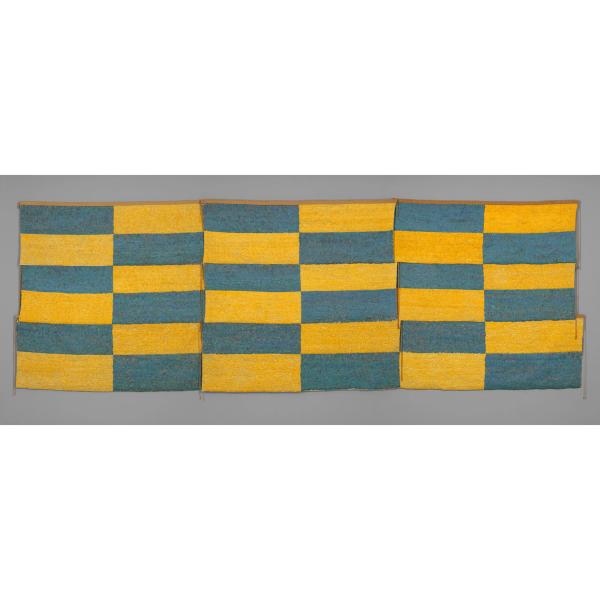Nine Feathered Panels
En 1943 fue encontrado un grupo importante de aproximadamente noventa y seis paneles de plumas en el valle de Churunga, en la costa Sur de Perú. Los paneles fueron enrollados y guardados en grandes vasijas de cerámica que luego fueron enterradas en un centro ceremonial conocido como Corral Redondo. Cada panel fue densamente cubierto con decenas de miles de plumas, principalmente plumas de guacamayo azul y amarillo, un ave que vive en la selva tropical amazónica. Las plumas fueron atadas a hilos de algodón una por una y a mano. Luego fueron cosidas a paneles lisos de tela de algodón. Es probable que estos paneles, de los cuales nueve están presentados, hayan adornado alguna vez las paredes de un edificio.
Further information
The discovery of an ancient burial or ceremonial site in the upriver region of the Churunga Valley, in far south Peru, received little attention in the turbulent world of 1943. Decades later, it would take two generations of Andean scholars to painstakingly piece together the puzzling story of this discovery, which included the largest and most spectacular find of Precolumbian Peruvian feather work to date.
Protected from decay by being rolled, placed into large ceramic jars, and buried in the arid soil, the cache included an estimated ninety-six panels, each densely covered with tens of thousands of small glossy macaw body feathers, primarily from the blue and yellow macaw (Ara ararauna). Although these panels were found in the dry western foothills of the Andes, the birds’ home is the Amazonian rainforest, far to the east. The effort required to secure such a mind-bogglingly large supply of either feathers or live birds suggests that colorful feathers were highly valued.
The panels are of roughly similar dimensions, and the majority feature alternating rectangles of blue and yellow feathers, which came from the macaw’s dorsal and ventral sides, respectively. The panels have a woven heading tape, and most also include braided cords that hang from the narrow sides. Although the cords suggest that these works were meant to be secured to some kind of structure, their actual function remains frustratingly illusive.
Christine Giuntini, Conservator, 2016
References
Bird, Junius B. 1958. Art of Ancient Peru: Selected Works from the Collection. Checklist with commentary of an exhibition at the Museum of Primitive Art, Feb 19–May 18, 1958. New York: Museum of Primitive Art. (unpaginated)
King, Heidi. 2013. "The Wari Feathered Panels from Corral Redondo, Churunga Valley: A Re-examination of Context." Ñawpa Pacha, Journal of Andean Archaeology 33 (1): 23–42.
Artwork Details
- Title:Nine Feathered Panels
- Date:600–900 CE
- Geography:Peru, South Coast
- Culture:Wari
- Medium:Feathers on cotton, camelid hair
- Dimensions:H. 81 1/2 in. × W. 20 ft. 1 3/4 in. (207 × 614 cm)
- Classification:Textiles-Featherwork
- Credit Line:The Michael C. Rockefeller Memorial Collection, Bequest of Nelson A. Rockefeller, 1979
- Object Number:1979.206.466–.473, .464
- Curatorial Department: The Michael C. Rockefeller Wing
Audio

1654. Paneles de plumas, artista(s) wari
Arabel Fernández López
ARABEL FERNÁNDEZ LÓPEZ: Frente a ustedes tienen una colección increíble conformada en este caso por nueve paneles decorados con estas plumas de azul brillante y amarillo que fueron encontradas en el sitio de Corral Redondo.
JOSÉ MARÍA YAZPIK (NARRADOR): Los artistas que crearon esta obra unieron hilos de plumas en filas superpuestas a un textil de soporte finamente tejido. Elaboraron una superficie ininterrumpida de un color suntuoso y luminoso que oculta por completo la valiosa tela que hay debajo. Arqueóloga Arabel Fernández López.
ARABEL FERNÁNDEZ LÓPEZ: Aproximadamente por cada panel ellos usaron 16 000 plumas. Imagínense la cantidad de plumas que deben haber usado para estos nueve paneles. De las cuales obtuvieron las plumas, que es un guacamayo. Probablemente ellos criaban especialmente estas aves para la obtención de las plumas. Además hay que indicar que esta el hábitat de estos de estas aves es en la selva.
JOSÉ MARÍA YAZPIK: La asombrosa cantidad y origen de las plumas son un testimonio de la inmensidad del imperio wari. Corral Redondo, donde se desenterraron los paneles, se encuentra en la costa sur del Perú, lejos tanto de las selvas tropicales orientales como de la capital de las tierras altas wari.
ARABEL FERNÁNDEZ LÓPEZ: Desafortunadamente se recuperaron, no por medios científicos. Ellos informan que estos paneles se encontraron enrollados dentro de unas grandes urnas de estilo Wari. Y ellos mencionan el hallazgo de ocho urnas y en total unos 96 paneles que ahora se encuentran distribuidos en museos alrededor del mundo, en diferentes museos.
Su función o el uso que tuvieron es todavía un enigma. Estas telas no tienen ninguna evidencia de uso y tampoco tenemos alguna referencia que nos indique cuál habría sido su función final. Pero de hecho y definitivamente su manufactura tuvo un propósito muy especial.
More Artwork
Research Resources
The Met provides unparalleled resources for research and welcomes an international community of students and scholars. The Met's Open Access API is where creators and researchers can connect to the The Met collection. Open Access data and public domain images are available for unrestricted commercial and noncommercial use without permission or fee.
To request images under copyright and other restrictions, please use this Image Request form.
Feedback
We continue to research and examine historical and cultural context for objects in The Met collection. If you have comments or questions about this object record, please contact us using the form below. The Museum looks forward to receiving your comments.